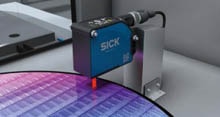Battery cell production and its processes are far from fully developed. To speed up the manufacturing process for battery cells, the Technical University of Munich (TU Berlin) has developed a folding process that allows higher throughput rates. At higher machine and process speeds, however, the requirements on the automation engineering also increase. The sensors from SICK play a decisive role in solving these requirements.
Full speed ahead for electromobility: Increasing throughput in battery cell folding
Battery technology – the heart of electromobility
It is expected that by 2030 the majority of cars produced will be electrically operated. That is why the production capacity for battery cells is rising and the predicted investments in battery cell factories are already exceeding by several fold the global production volume in 2022. A core process in the production of battery cells is the processing of the electrode foils and separators. Different processes are used for different cell types. This includes the winding of foil tracks to produce so-called “jelly rolls”. Various stacking processes ensure that cell stacks are formed from the individual anodes, cathodes and separators. The winding processes are already characterized by high speeds and process stability. And the stacking of battery cells offers advantages for the electrical performance of the batteries. The combination of the two processes is referred to as Z-folding, where individual electrode sheets are connected with a separator just prior to folding.
High stacking speed as key challenge
When further developing the stacking and Z-folding processes for battery cells, increasing the stacking speed is a key challenge. A team lead by Prof. Franz Dietrich, Professor for Handling and Assembly Technology at the Institute of Machine Tools and Factory Management, TU Berlin, is tackling this challenge. One related task is: The speeding up of the processes must not, however, have a negative impact on the precise placement accuracy of the stacked electrode sheets. In contrast to conventional process alternatives that use sequential pick-and-place operations, TU Berlin therefore developed a continuous process sequence: from pickup and handling right through to positioning and alignment of the electrode sheets. Compared to established process sequences, the aim in future is to significantly increase the productivity with a constant and up to 2,000 mm/s fast feed rate for the materials.
Overcoming the limits of automation engineering

Such a high system speed cannot be achieved using traditional automation engineering. No conventional method of collecting sensor data in PLC cycles is suitable for positioning and aligning the individual electrode sheets in a continuous feed process. SICK sensors solve this problem, however.
Dr. Arne Glodde, Research Group Leader at TU Berlin Chair of Handling and Assembly Technology Research explains: “Thanks to the combined use of the fast detection sensors from SICK and the timestamps of the XFC technology from Beckhoff, we are no longer bound by the limitations of collecting data in PLC cycles and can utilize the full speed of the sensors.”
Two sensor solutions from SICK are being used for this purpose: The WLL180T-2 fiber-optic sensor with its switching frequency of up to 31.2 kHz achieves a response time of ≤ 16 µs. Fiber-optic sensors can also be integrated into small installation spaces.
And using the KTS Prime contrast sensor from SICK, it is possible to increase the measurement resolution and feed speed even more: With a switching frequency of up to 70 kHz, response times of up to 3 µs are possible. The process at TU Berlin uses sensor pairs comprising either fiber-optic sensors or KTS Prime contrast sensors. This enables the sheet position in the feed direction as well as the angle of the front edge of the sheet to be detected and, if necessary, corrected.
But that’s not all: The experts at TU Berlin are continuing to work on speeding up the Z-folding process for battery cells and are jointly developing the battery manufacturing process with SICK.
Read more
Sensor intelligence in automotive production supports e-mobility
Digitally supported production with interoperable sensor communication
KTS and KTX: more than just print mark sensors






